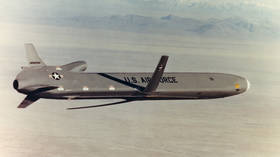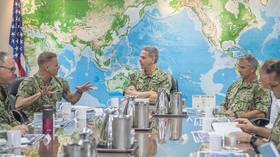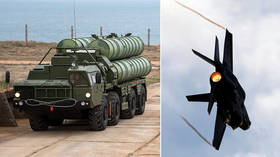Pentagon eager to test banned missiles after discarding Cold War-era nuke treaty

The Pentagon plans to test two types of missiles banned for over 30 years under the Intermediate Nuclear Forces Treaty – reinforcing suspicions it has been preparing for this for years.
Pentagon officials outlined a plan to produce a low-flying cruise missile with a potential range of around 1,000km and a ballistic missile capable of traveling 3,000 to 4,000km. Neither would be nuclear armed, the officials said, though with no treaty to abide by, there would be little holding them back from embracing a return to a Cold War-style arms race. The tests are scheduled to take place immediately after the US' official withdrawal from the INF treaty with Russia is finalized.
Also on rt.com Calling Dr. Strangelove: The threat of nuclear war cannot prevent World War III foreverThe cruise missile would be ready for flight-testing in August, while the longer-range projectile would be set for testing in November, according to the officials, who spoke to the press on Wednesday on condition of anonymity. A successful bid to rescue the INF Treaty could theoretically head off development of both weapons, but arms race skeptics appear to be in short supply in Washington, with even the treaty's supporters blaming Russia for breaking it with their 9M729 cruise missile – accusations the Russians have countered by pointing to the US' massive drone fleet and Tomahawk-compatible "defensive" missile systems stationed in Europe.
"It is unwise for the US and NATO to match an unhelpful action by Russia with another unhelpful action," AP quoted Daryl Kimball of the Arms Control Association as saying. Kimball pointed out that the Pentagon hadn't even made a case that such missiles were strategically necessary. "If the United States tries to bully NATO into accepting deployment of such missiles, it is going to provoke a destabilizing action-reaction cycle and missile race."
Also on rt.com US withdraws from INF Treaty in 180 days – PompeoThe Pentagon announced on Monday that it would begin manufacturing components for the banned missile systems – "activities that until February 2 would have been inconsistent with our obligations under the treaty," a Pentagon spokeswoman was careful to point out, citing the date on which President Trump officially announced the start of the US' withdrawal from the treaty. The Russian Ministry of Defense, however, said last month it believes the US has been building a Raytheon production facility with the intent of producing the banned weaponry since 2017 and has merely been looking for an excuse to ditch the treaty.
The INF banned both nuclear and conventional ground-launched missiles with ranges between 500km and 5,500km in 1987. US and Russian officials alike have expressed concern the Trump administration is using the dissolution of the treaty as an excuse to stock its arsenal with previously-banned weapons.
If you like this story, share it with a friend!














